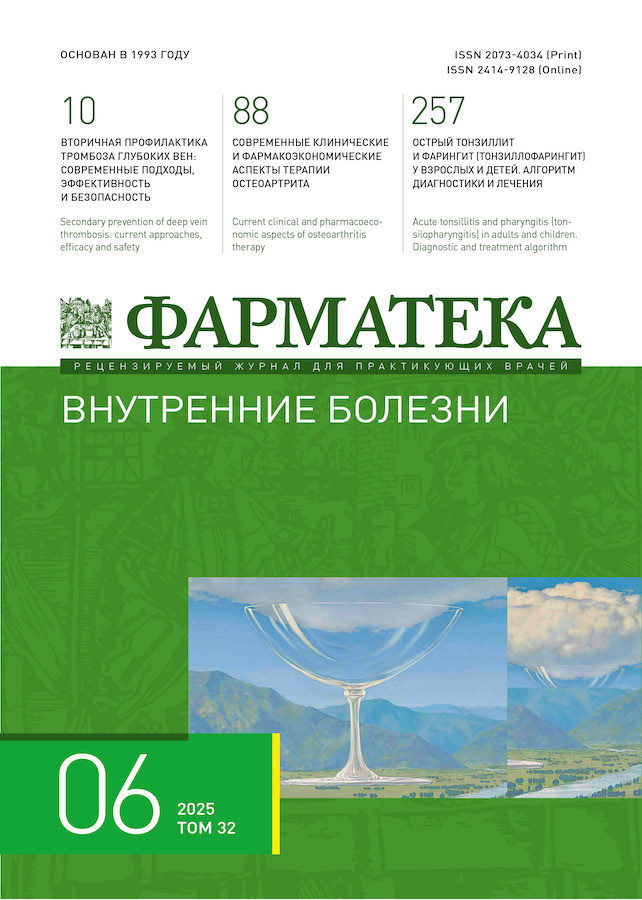Clinical efficacy of La Roche-Posay dermatological laboratory products in the treatment of dermatological toxicity associated with anticancer therapy: results of a prospective study
- Autores: Stepanova Y.L.1, Klemenova I.A.1, Garanina O.E.1, Mironycheva A.M.1, Uskova K.A.1, Makarova S.S.1, Shlivko I.L.1
-
Afiliações:
- Privolzhsky Research Medical University
- Edição: Volume 32, Nº 6 (2025)
- Páginas: 190-197
- Seção: Oncology
- URL: https://journals.eco-vector.com/2073-4034/article/view/695561
- DOI: https://doi.org/10.18565/pharmateca.2025.6.190-197
- ID: 695561
Citar
Texto integral
Resumo
Background: Modern anticancer therapy, including targeted agents and immunotherapy, is associated with a high incidence of dermatological adverse events (75–90% with EGFR inhibitors and over 30% with immunotherapy). These reactions range from mild to severe, significantly impairing patients’ quality of life and decreasing treatment adherence. Despite existing approaches to treatment, there remains a need for effective and safe methods for the treatment and prevention of this condition.
Objective: Evaluation of the efficacy of topical dermatological agents for the treatment of skin toxicity in patients receiving anticancer therapy.
Materials and methods: This prospective, open-label, non-randomized study included 44 patients with grade 1–3 dermatological toxicity, assessed using the standardized NCI Common Terminology Criteria for Adverse Events Version 5 (CTCAE v 5.0) scale [1]. The main group (n=23) received a combination of the La Roche-Posay Dermatological Laboratory products: LIPIKAR SYNDET AP+ lipid-replenishing face and body cream-gel once daily, LIPIKAR BAUME AP+M lipid-replenishing balm 1–2 times daily, and CICAPLAST BAUME B5+ restorative balm 2–3 times daily on damaged skin areas (cracks, excoriations, erosions). The comparison group (n=21) used other emollients. Local skin status was assessed on days 0, 7–10, and 14–21 using the Dermatology Life Quality Index (DLQI) questionnaire. Concurrently, skin lesions were photographically documented using the specialized FotoFinder system.
Results. The mean age of the participants was 58 years, with a predominance of women (56.8%). According to the severity of skin manifestations, patients were distributed as follows: grade 1 (grade I) – 29.5% of cases, grade 2 (grade II) – 59.1%, grade 3 (grade III) – 11.4%. Of all clinical forms of skin toxicity, acneiform rashes were the most common (36.4% of cases). The analysis of efficacy revealed statistically significant differences between the groups: a significant decrease in the total DLQI score in the main group (8.10 → 2.30; p < 0.001), in contrast to the control group (8.29 → 5.43; p < 0.001). The positive effect in the main group was evident as early as days 7–10 of therapy. It is important to note that no adverse events associated with the use of the study drugs were recorded in either group.
Conclusion: La Roche-Posay Dermatological Laboratory products demonstrate a more pronounced and rapid therapeutic effect compared to other emollients, confirming their inclusion in treatment and prevention regimens for dermatological toxicity.
Palavras-chave
Texto integral
Sobre autores
Yana Stepanova
Privolzhsky Research Medical University
Autor responsável pela correspondência
Email: Stepanova.ya09@yandex.ru
ORCID ID: 0009-0004-9228-7770
Teaching Assistant, Department of Skin and Venereal Diseases
Rússia, Nizhny NovgorodI. Klemenova
Privolzhsky Research Medical University
Email: Stepanova.ya09@yandex.ru
ORCID ID: 0000-0003-1042-8425
Rússia, Nizhny Novgorod
Oksana Garanina
Privolzhsky Research Medical University
Email: Stepanova.ya09@yandex.ru
ORCID ID: 0000-0002-7326-7553
Rússia, Nizhny Novgorod
Anna Mironycheva
Privolzhsky Research Medical University
Email: Stepanova.ya09@yandex.ru
ORCID ID: 0000-0002-7535-3025
Rússia, Nizhny Novgorod
Ksenia Uskova
Privolzhsky Research Medical University
Email: Stepanova.ya09@yandex.ru
ORCID ID: 0000-0002-1000-9848
Rússia, Nizhny Novgorod
Svetlana Makarova
Privolzhsky Research Medical University
Email: Stepanova.ya09@yandex.ru
ORCID ID: 0009-0002-8723-1997
Rússia, Nizhny Novgorod
Irena Shlivko
Privolzhsky Research Medical University
Email: Stepanova.ya09@yandex.ru
ORCID ID: 0000-0001-7253-7091
Rússia, Nizhny Novgorod
Bibliografia
- Common Terminology Criteria for Adverse Events (CTCAE). Version 5.0 Published: November 27, 2017. URL: https://dctd.cancer.gov/research/ctep-trials/for-sites/adverse-events (date of access: 30.07.2025)
- Slamon D.J., Leyland-Jones B., Shak S., et al. Use of chemotherapy plus a monoclonal antibody against HER2 for metastatic breast cancer that overexpresses HER2. N Engl J Med. 2001;344(11):783–792. https://dx.doi.org/10.1056/NEJM200103153441101
- Ribas A., Wolchok J.D. Cancer immunotherapy using checkpoint blockade. Science. 2018;359(6382):1350–1355. https://dx.doi.org/10.1126/science.aar4060
- Hwang S.J., Carlos G., Wakade D., et al. Cutaneous adverse events (AEs) of anti-programmed cell death (PD)-1 therapy in patients with metastatic melanoma: A single-institution cohort. J Am Acad Dermatol. 2016;74(3):455-461.e1. https://dx.doi.org/10.1016/j.jaad.2015.10.029
- Lacouture M.E., Sibaud V., Gerber P.A., et al.; ESMO Guidelines Committee. Prevention and management of dermatological toxicities related to anticancer agents: ESMO Clinical Practice Guidelines. Ann Oncol. 2021;32(2):157–170. https://dx.doi.org/10.1016/j.annonc.2020.11.005
- Lacouture M.E., Anadkat M., Jatoi A., et al. Dermatologic toxicity occurring during anti-EGFR monoclonal inhibitor therapy in patients with metastatic colorectal cancer: a systematic review. Clin Colorectal Cancer. 2018;17(2):8596. https://dx.doi.org/10.1016/j.clcc.2017.12.004
- Bouché O., Ben Abdelghani M., Labourey J.L., et al. Management of skin toxicities during panitumumab treatment in metastatic colorectal cancer. World J Gastroenterol. 2019;25(29):4007–4018. https://dx.doi.org/10.3748/wjg.v25.i29.4007
- Borovicka J.H., Calahan C., Gandhi M., et al. Economic Burden of Dermatologic Adverse Events Induced by Molecularly Targeted Cancer Agents. Arch Dermatol. 2011;147(12):1403–1409. https://dx.doi.org/10.1001/archdermatol.2011.719
- Hopkins A.M., Rathod A.D., Rowland A., et al. Risk factors for severe rash with use of vemurafenib alone or in combination with cobimetinib for advanced melanoma: pooled analysis of clinical trials. BMC Cancer. 2020;20(1):157. https://dx.doi.org/10.1186/s12885-020-6659-0
- Dreno B., Khosrotehrani K., De Barros Silva G., et al. The role of dermocosmetics in the management of cancer-related skin toxicities: international expert consensus. Support Care Cancer. 2023;31(12):672. https://dx.doi.org/10.1007/s00520-023-08116-4
- Dreno B., Bensadoun R.J., Humbert P., et al. Algorithm for dermocosmetic use in the management of cutaneous side-effects associated with targeted therapy in oncology. J Eur Acad Dermatol Venereol. 2013;27(9):1071–1080. https://dx.doi.org/10.1111/jdv.12082
Arquivos suplementares














